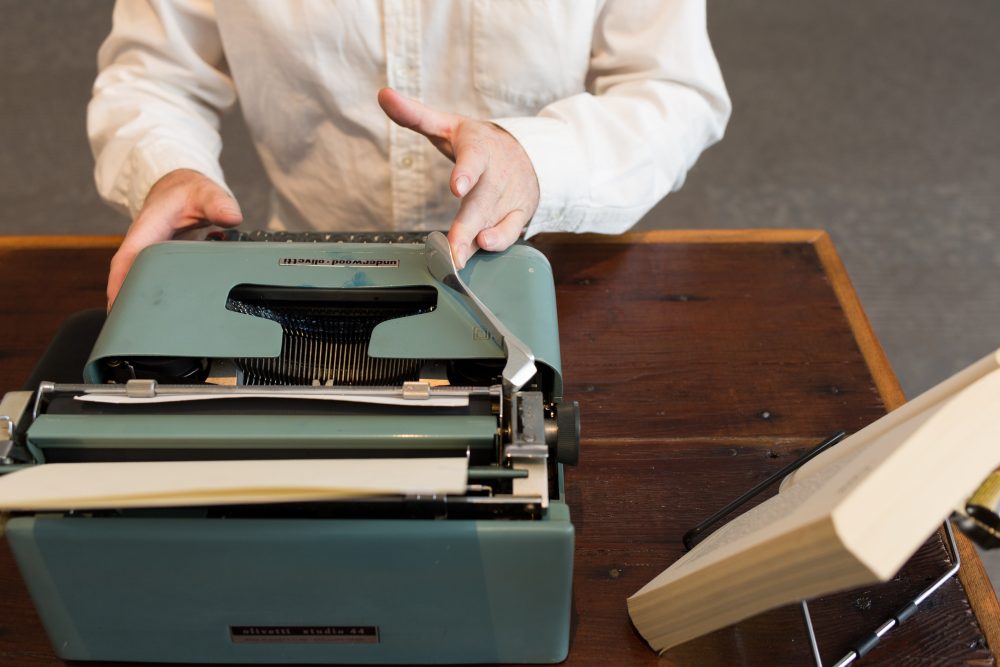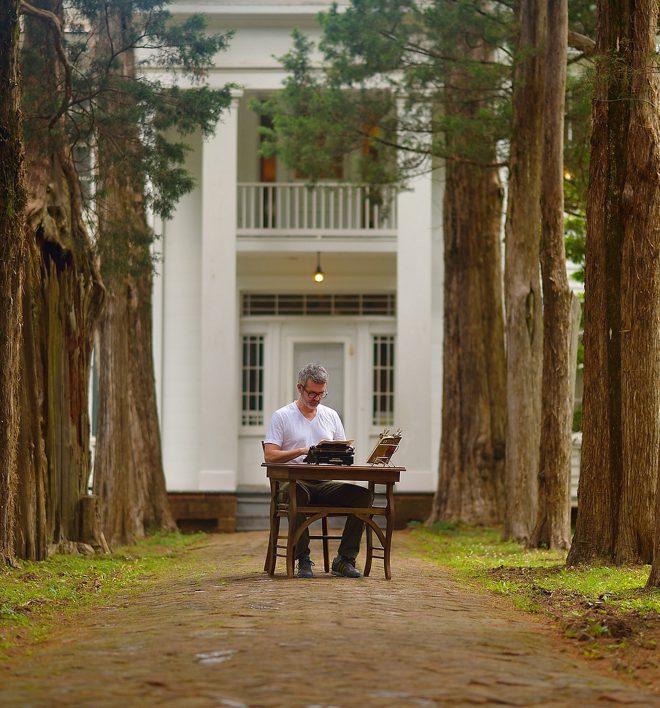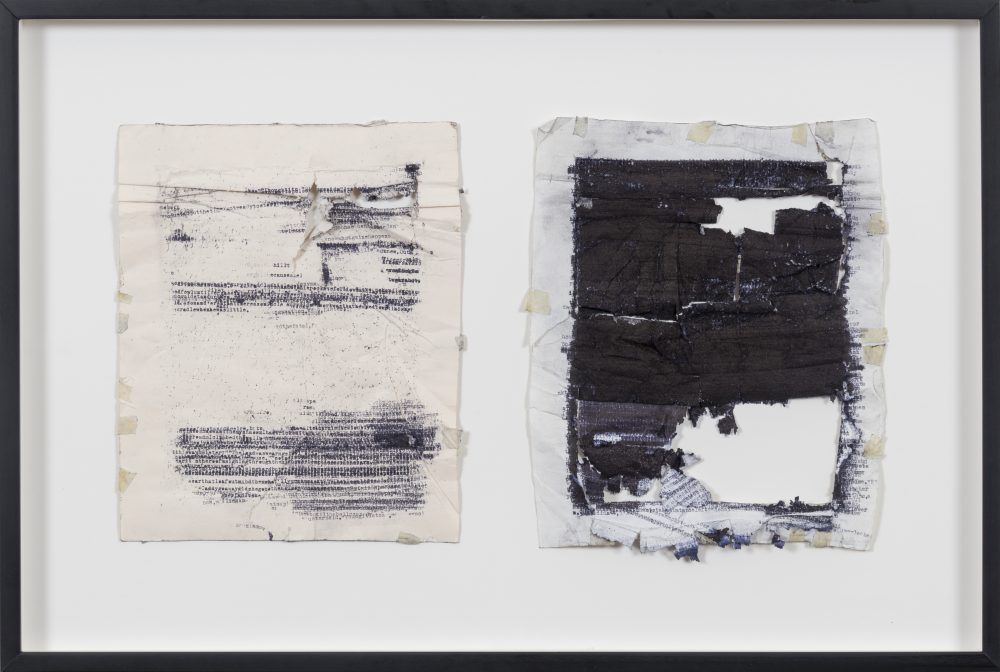The Untortured Artist: Tim Youd’s Literary Pilgrimage
Nathan C. Martin examines Tim Youd’s journey through the literary canon.

Tim Youd re-typing John Kennedy Toole’s A Confederacy of Dunces at the New Orleans Museum of Art in October 2015, as part of his project 100 Novels. Photo by Roman Alokhin. Courtesy the artist and the New Orleans Museum of Art.
Tim Youd has undertaken a search.
What is the nature of the search? you ask. Really it is very simple, at least for a fellow like Tim Youd; so simple that it is easily overlooked. The search is what anyone would undertake if he were not sunk in the everydayness of his own life. To become aware of the possibility of the search is to be onto something. Not to be onto something is to be in despair.
Literature buffs will recognize I’m riffing on The Moviegoer, Walker Percy’s existential romp through New Orleans and winner of the 1962 National Book Award. It’s what Youd was re-typing when I found him in the lobby of the Prytania Theatre last month, his Smith Corona typewriter—the same style Percy used—sitting atop a plastic table beside the novel, which was propped up in a stand and held open with large metal clips. Of all the New Orleans movie theaters Percy’s protagonist Binx Bolling visits during his own search in The Moviegoer, the Prytania is the only one still in operation. Its old-timey aesthetic—red floral carpet, brick walls, posters for upcoming features framed with round yellow bulbs—made Youd’s clickety-clacking on a typewriter seem somehow fitting. But a patron trying to watch a matinee of The Hunger Games: Mockingjay, Part 2 came out to complain about the racket.
Youd is in the midst of a years-long project called 100 Novels, for which he is re-typing word-for-word—you guessed it—100 novels in locations associated with each book. The past several months have found him in Louisiana, where, in addition to The Moviegoer, he’s worked his way through John Kennedy Toole’s A Confederacy of Dunces, Ernest J. Gaines’ The Autobiography of Miss Jane Pittman, James Wilcox’s Modern Baptists, and Robert Penn Warren’s All the King’s Men.
What has always struck me about that passage about “the search” from The Moviegoer is how weirdly vague and breezy it is. Bolling acknowledges that his audience is probably curious about “the search” (“What is the nature of the search? you ask”) and then proceeds not to offer anything resembling an explanation. But whatever the search is, Bolling sure does make it sound pleasant: “This morning, for example, I felt as if I had come to myself on a strange island. And what does such a castaway do? Why, he pokes around the neighborhood and he doesn’t miss a trick.”
When I spoke with Youd at the New Orleans Museum of Art—where he continued re-typing The Moviegoer in a second-floor gallery, his tap-tap-tapping echoing out into the atrium—I sensed a similar breeziness and ease. His purpose in re-typing the novels, he said, is to become a better reader. His search is one of personal fulfillment.
“This is a way for me to force my way through a rigorous journey where I’m really reading closely a bunch of novels, and I’m going to be a good reader and come out of this being an even better reader,” he said. “That makes it rewarding for me because that makes it tie into the thing I’ve enjoyed most in my life, which is reading.”
Youd had often incorporated literature and text into his art, but he did not have a fully formed project in mind when he sat down in 2013 to re-type his first novel, Hunter S. Thompson’s Fear and Loathing in Las Vegas, in his studio in Los Angeles. (He had recently learned that Thompson re-typed The Great Gatsby and A Farewell to Arms as writing exercises.) He found the act pleasurable and continued with Charles Bukowski’s Women and Philip Roth’s Portnoy’s Complaint. While re-typing some Henry Miller novels, Youd got the idea to turn his new pursuit into a series of site-specific performances. He banged out Tropic of Capricorn on the sidewalk in Brooklyn a few blocks from Miller’s childhood home.
“It was in the late spring—May, maybe—and after I was there for a few days people were asking me for directions. I became part of the landscape,” Youd said. “I had a great time.”

Tim Youd re-typing William Faulkner’s The Sound and the Fury at the Faulkner House in Oxford, MS, in June 2014, as part of his project 100 Novels. Photo by Robert Jordan/Ole Miss Communications. Courtesy the artist and the New Orleans Museum of Art.
Youd is on pace to finish his project sometime around 2020; nearly three years since he typed Fear and Loathing, he’s not yet completed half the books on his list. Each novel takes a week or two, depending on its length, but there are stretches of downtime between activity. He said he decided to make the project last so long—to do 100 novels instead of, say, 10, or even 50—simply because he enjoys re-typing the novels and visiting different literary locations so much. He argues his enjoyment improves both his art and his life.
“If art’s going to be any good, you have to satisfy yourself,” Youd said. “I could have typed a few novels if I didn’t like doing it, I could have gone through the mechanical exercise—and I suppose I could do 100 and waste ten years of my life. But if I wasn’t really present, that’s what it would feel like: a wasted opportunity.”
The notion of an artist’s presence is frequently integral to performance art, notably in Marina Abramović’s blockbuster The Artist is Present, 2010, for which she sat intently, locking eyes with visitors to New York’s Museum of Modern Art for nearly 750 hours. Abramović and others practice what is sometimes known as endurance or durational art: Chris Burden stuffed himself inside a locker for five days for Five Day Locker Piece, 1971; Emma Sulkowicz drug a mattress around the Columbia University campus for an entire school year, making physical the burden of sexual assault, for Mattress Performance (Carry That Weight), 2014-15; Vito Acconci jerked off beneath a wooden ramp for three weeks for Seedbed, 1972, simultaneously vocalizing his erotic fantasies through a loudspeaker. While Youd’s project, like these, spans an impressive amount of time and involves somewhat grueling physical action (carpal tunnel syndrome, anyone?), it’s striking the degree to which he seems to be treating it as a long vacation.
In a way, this sense of a relaxed getaway fits Youd’s project. In addition to making himself a better reader, Youd said 100 Novels is also meant to be something of a critical exploration of the literary pilgrimage—for instance, the droves of tourists pouring each year into Ernest Hemingway’s Key West house to see the six-toed cats. By jetting across the Atlantic to re-type Anthony Burgess’ A Clockwork Orange in Manchester, swooping into Miami Beach to tap out Elmore Leonard’s Get Shorty, stopping into Oxford to do William Faulkner’s The Sound and the Fury, and then heading to Beverly Hills to re-type Upton Sinclair’s Oil!, Youd said he’s probing the dissonance inherent in visiting literary heritage sites. On one hand, the famous association between Hemingway and his malformed cats creates an absurd distance between the contemporary life of texts and what their writers originally intended. But the literary pilgrimage can, in other cases, be earnest, a journey filled with meaning.
“What is this [literary pilgrimage] experience really about? We fetishize famous dead authors and they become something other than what they were,” Youd said. “Is what I’m doing ridiculous? Is it a little absurd? Yeah, it is, but it doesn’t mean it’s not devotional. I’m in both spots. That’s when I’m most likely to make interesting discoveries.”
What those discoveries might be remains unclear. Though Youd can articulate with ease the ways in which the novels he has re-typed function on a structural and compositional level and can offer comparative literary analyses off the cuff, his is a hermetic endeavor. Thompson may have used re-typing as an exercise to create his own literature to share with the world, but 100 Novels more closely resembles Kenneth Goldsmith’s “Day,” for which the conceptual poet re-typed the entire September 1, 2000, issue of The New York Times and published it in an 836-page tome. The only objects that remain as evidence of Youd’s work are diptychs of two tattered, taped-together pages. When Youd reaches the end of the page, he simply begins again at the top, over the sentences he’s already typed, eventually filling the page with ink and often ripping through it and marking the sheet taped below it. On display in frames, the sheets evoke the shape of an open book and bear the markings of the sustained violence of the typewriter’s hammer repeatedly slapping the paper.

Tim Youd, William Faulkner’s The Sound and the Fury, 2014. Courtesy the artist and the New Orleans Museum of Art.
If all of his self-gratification makes Youd’s search seem primarily masturbatory, that sense is not diminished by looking at his prior projects, which dealt mostly with another subject that gives Youd great fulfillment. In the years preceding 100 Novels, Youd spent his time crafting kinetic sculptures with literary quotes on them like: “They all have cunts. Right there under their dresses. Cunts—for fucking!” from Portnoy’s Complaint; and a long, catalogue-like quote by Henry Miller listing “vegetative cunts which make no response unless you pull them up by the roots…religious cunts which smell like Seventh Day Adventists and are full of beads, worms, clamshells, sheep droppings and now and then dried breadcrumbs…mammalian cunts which are lined with otter skin and hibernate during the long winter…” and so forth. Youd also created a series of large paintings of hairy vaginas. Not one to make much of an effort to veil his misogyny, Youd explained in a video about this period of his output that he prefers to put women up on pedestals because that makes it easier to look up their skirts. Nearly halfway through 100 Novels, Youd has re-typed a total of two books written by a woman—To the Lighthouse and Orlando, both by Virginia Woolf.
“If a bias is shown, that’s what happens,” he said. “I wouldn’t want to pander. There are plenty of women writers whose works I’ve enjoyed and continue to enjoy. It’s just the way it came out.”
Youd added that he imagined the final list would include around 25 books by women. He’ll be taking on Flannery O’Connor’s Wise Blood and The Violent Bear it Away in Georgia next month.
So what is the nature of Youd’s search? It’s simple, so simple that it is easily overlooked. Youd loves literature. He loves art. He is onto something and is therefore not in despair, not sunk into the everydayness of his life. He used to be an investment banker. Now he is typing novels he enjoys, not novels he does not enjoy. He is typing on a typewriter. He is becoming a better reader. He is conducting interviews. He is showing people that using a typewriter is still possible, and that reading and writing can present tactile pleasure and sound. He is poking around the canon and not missing a beat. He is tap-tap-tapping away at a museum near you. He is having a great time satisfying himself.
Editor's Note
“Tim Youd: 100 Novels,” an exhibition accompanying the artist’s performances, is on view through February 21, 2016, at the New Orleans Museum of Art (1 Collins Diboll Circle).



